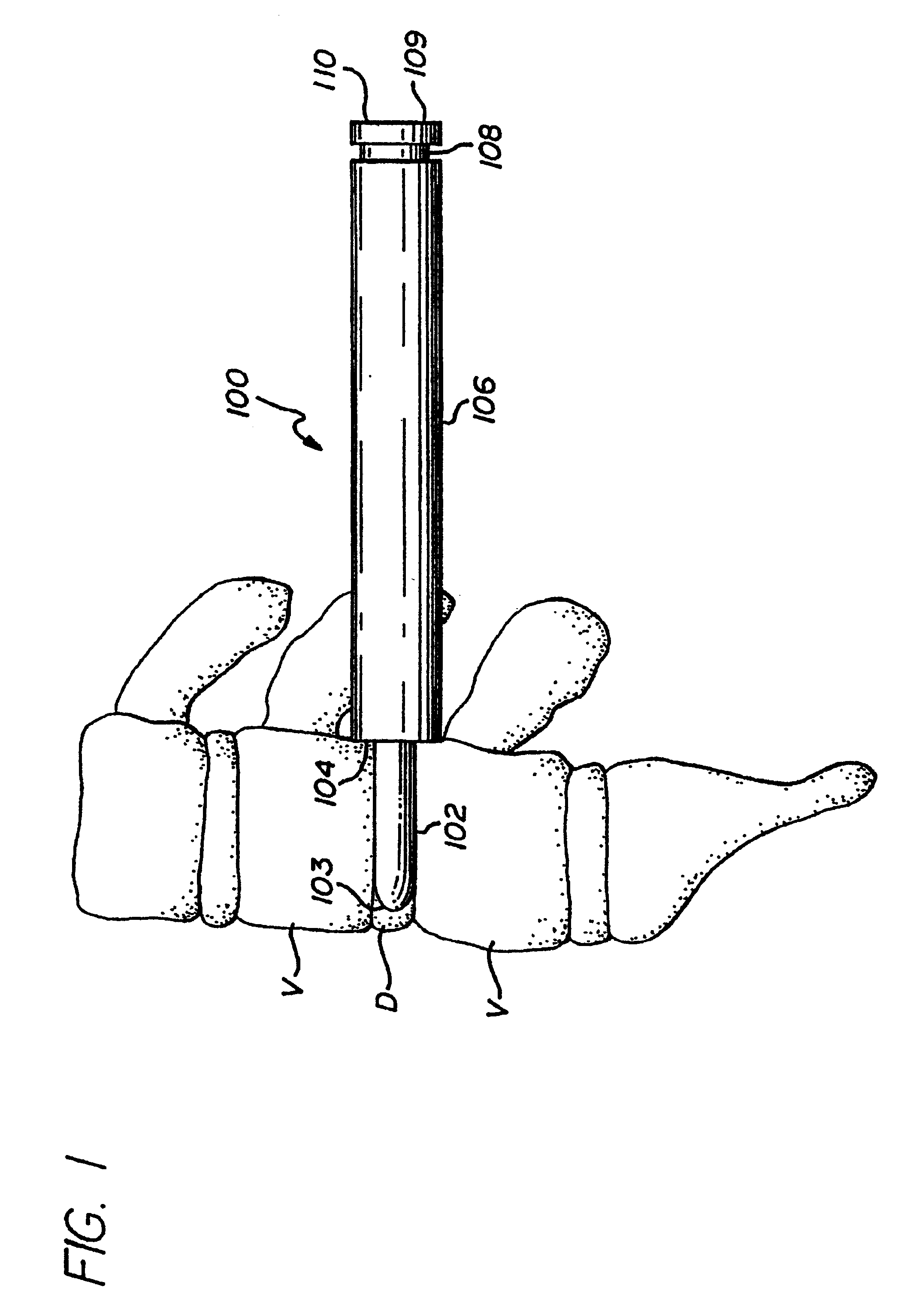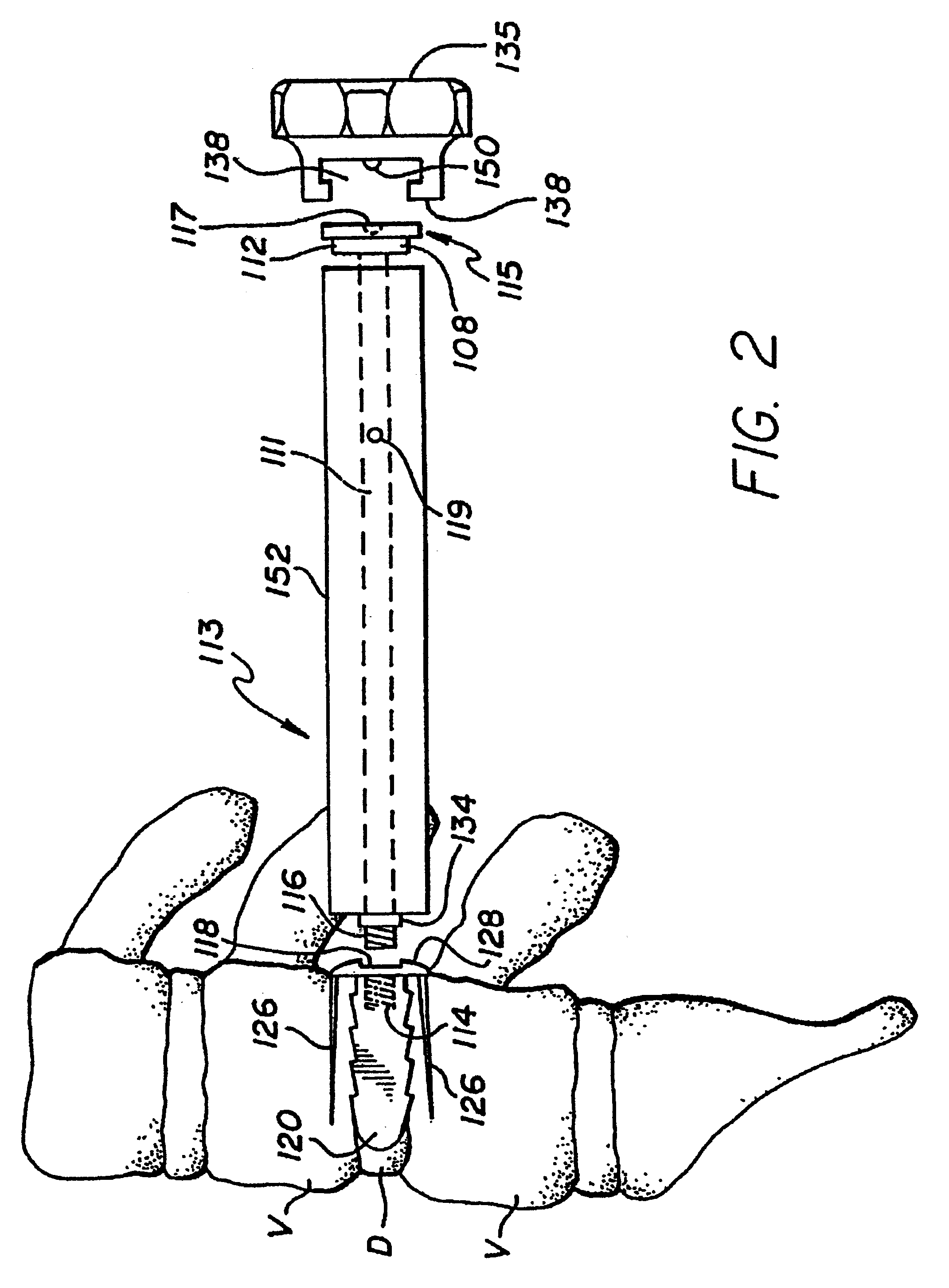Placing nothing into this space allows the space to collapse which may result in damage to the nerves; or the space may fill with
scar tissue and eventually lead to a reherniation.
The use of bone to fill the space is less than optimal in that bone obtained from the patient requires additional
surgery and is of limited availability in its most useful form, and if obtained elsewhere, lacks living bone cells, carries a
significant risk of infection, and is also limited in supply as it is usually obtained from accident victims.
Furthermore, regardless of the source of the bone, it is only marginal structurally and lacks a means to either stabilize itself against dislodgement, or to stabilize the adjacent vertebrae.
No such device has been found that is medically acceptable.
Furthermore, these devices are limited in that they seek to perform as temporary structural members mechanically replacing the removed vertebrae (not a removed disc), and do not intrinsically participate in supplying osteogenic material to achieve cross vertebrae bony fusion.
In summary, none of these devices are designed to be nor can be used within the
disc space.
Moreover, these devices do not replace a damaged disc, and do not intrinsically participate in the generation of a bony fusion.
1. Safety--The present invention provides for a
system of completely guarded
instrumentation so that all contiguous vital structures (e.g. large blood vessels, neural structures) are absolutely protected. The
instrumentation of the present invention also makes overpenetration by the
drill impossible. Such overpenetration in the
cervical spine, for example, would result in the total
paralysis or death of the patient. In the
thoracic spine, the result would be complete
paraplegia. In the
lumbar spine, the result would be
paraplegia or a life-threatening perforation of the
aorta,
vena cava, or iliac vessels.
This is extremely dangerous and the pounding occurs directly over the
spinal cord which is precariously vulnerable to percussive injury.
Furthermore, since the BAGBY device is pounded into a smooth hole under great resistance, and lacking any specific design features to secure it, the device is highly susceptible to forceful ejection which would result in great danger to the patient and clinical failure.
Because of the proximity of the
spinal cord, spinal nerves, and blood vessels, any
implant dislodgement as might occur with the BAGBY device might have catastrophic consequences.
As discussed, the BAGBY device lacks any specific means of achieving stability and since it is pounded in against resistance to achieve vertebral
distraction, and is susceptible to forceful dislodgement by the tendency of the two distracted vertebrae, to return to their original positions squeezing out the device.
Secondly, as the BAGBY device lacks any specific design features to
resist sliding, it may actually behave as a
third body allowing the translation of the vertebrae relative to the device and to each other.
Thirdly, any device can only provide stability if it remains properly, seated.
Fourthly, it is not pressure alone that causes the collapse of the bone adjacent to the
implant, but also bony
erosion that is caused by the motion under pressure of the implant against the bone.
As the bone graft to be inserted in Cloward's method was necessarily larger in
diameter than the hole drilled, the graft could not be inserted through the
drill guide.
Thus Cloward's method and instrumentation was inappropriate for posterior application.
In addition, the failure to provide continuous protection to the delicate neural structures from the instruments, as well as the bony and cartilaginous debris generated during the procedure, made Cloward's method inappropriate for posterior application.
Also, the
drill guide described by Cloward could not be placed posteriorly within the
spinal canal, as the foot plate would crush the nerves.
Modifying Cloward's
drill guide by removing the foot plate completely, would still leave the instrument unworkable as it would then lack stability, and would not be controllable for depth of seating.
While Wilterberger had taken the Cloward concept of circular drilling and
dowel fusion and applied it to the
lumbar spine from a
posterior approach, he had not provided for an
improved method, nor had he advanced the instrumentation so as to make that procedure sufficiently safe, and it rapidly fell into disrepute.
1. Failure to protect the surrounding tissues throughout the procedure, specifically, prior to drilling and until after the
insertion of the graft;
2. Failure to contain the debris, bony and cartilaginous, generated during the procedure;
3. Failure to optimize the contact of the cylindrical
drill hole and bone graft, the mismatch in their diameters resulting in incongruence of fit;
4. Failure to determine the optimal drill size prior to drilling;
5. Failure to determine the optimal amount of
distraction prior to drilling;
6. Inability to optimize the amount of
distraction so as to restore the normal spatial relationships between adjacent vertebrae;
7. Inability to create sufficient
working space within the
spinal canal (between the nerve roots and the dural sac) to make the procedure safe;
8. Absent a foot plate on the
drill guide, as necessitated by the close tolerances posteriorly, the inability to reliably insure that the drilling is parallel to the vertebral endplates;
9. The inability to insure equal
bone removal from the opposed vertebral surfaces; and
The inability to determine within the
spinal canal, the proper side by side positioning for dual drill holes.
 Login to View More
Login to View More  Login to View More
Login to View More 


